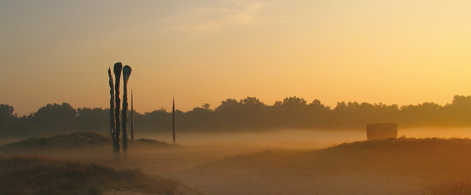On September 11 our artistic director Joop Mulder will be presenting the ‘Joop Mulder Plak’ for the third time. An incentive prize from Oerol Festival for artists who develop surprising work in the landscape of the Wadden Island Terschelling. Emke Idema, Sofie Doeland and Studio Buiten Werking are the three nominees this year. The award ceremony will take place in Harlingen.
The Joop Mulder Plak was first introduced in 2017 as a tribute to Joop’s role as the founder of Oerol. The prize offers artists and pioneers the opportunity for further development. In 2017, artist duo Hart van Veen and in 2018, Bart van de Woestijne won the Joop Mulder Plak. The winner receives a sum of money based on donations.
More information about the incentive prize and the three nominees can be found here .
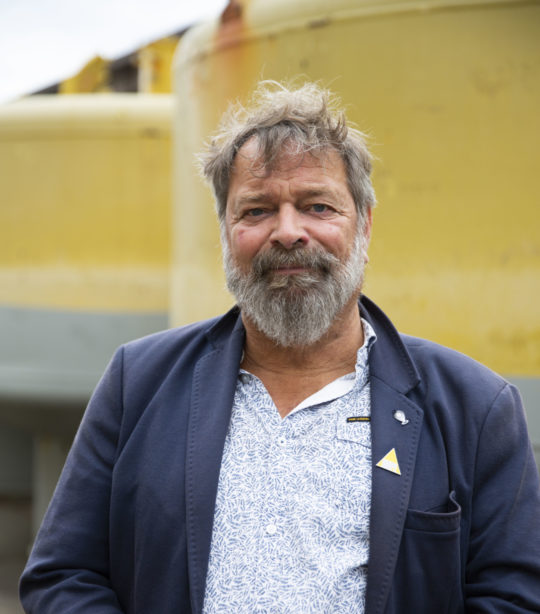
News from the German Wadden Island Föhr: the installation of the traveling group exhibition Moving Landscapes – still on Oerol Terschelling last month – is ready!
Five landscape works have been given a brand new (and also beautiful) place on the island because of the 10-year anniversary of Museum Kunst der Westküste.
The works on Föhr are: ‘Level’ by Bouke Groen, ‘Tumbling in Time’ by Sofie Doeland, ‘Here We Are’ by Theun Mosk, ‘rotation’ by Hart van Veen and ‘Luw’ by Firma Kluit.
The exhibition on Föhr can be admired from July 29 to September 29. More information and a handy map with the locations of the works can be found hier
The exhibition is freely accessible.

Photo: presentation press Moving Landscapes on Föhr | Date: 24 july 2019 | Work: ‘Luw’ van Firma Kluit
Moving Landscapes is a Sense of Place-initiative by artistic director and pionier Joop Mulder, in co-production with Oerol Terschelling and Museum Kunst der Westküste. The existing installation Camera Batavia by Arjen Boerstra is the spill and inspiration for the project. A group of artists were invited to create five new works around it.
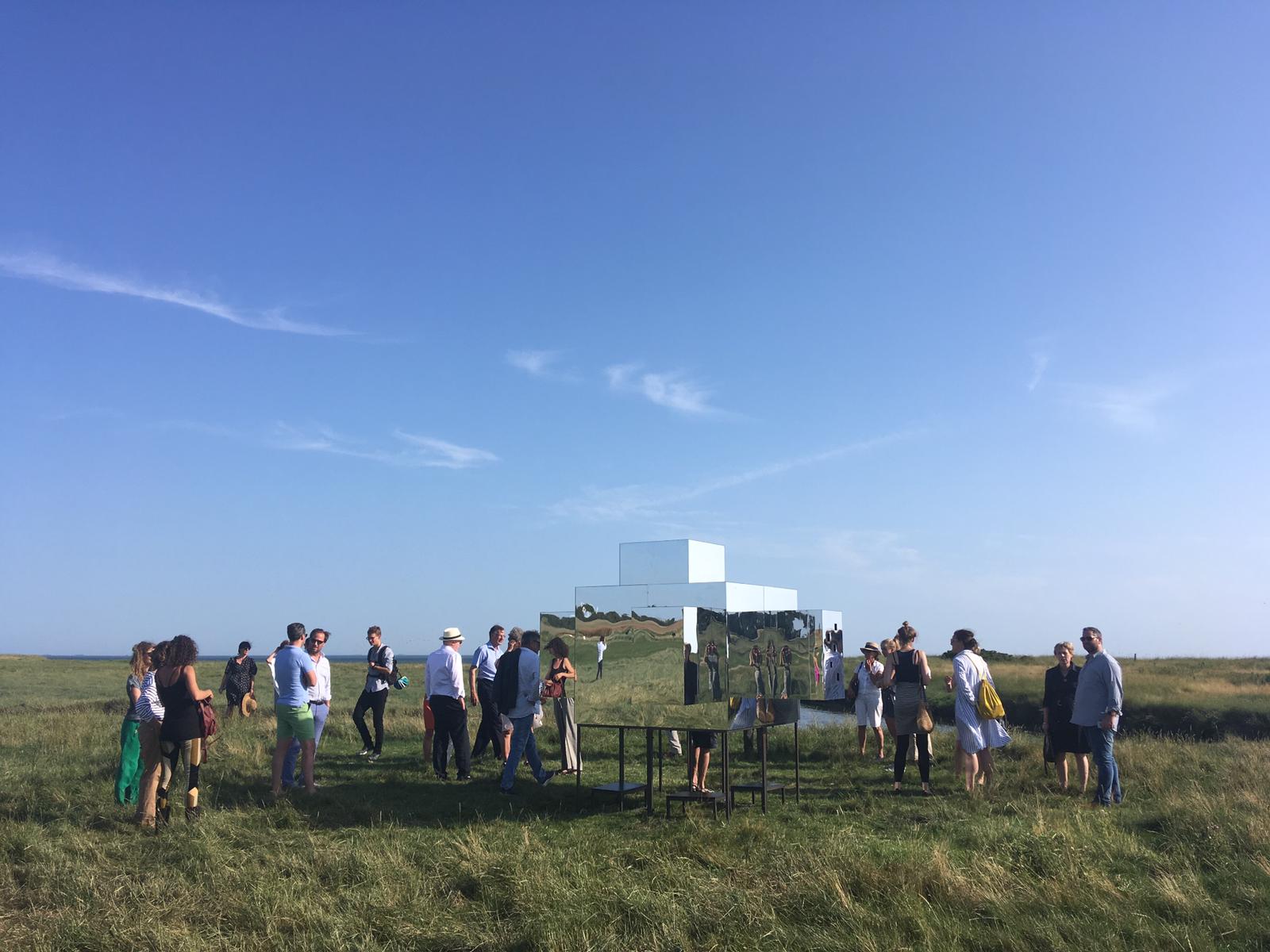
In 2009 the Wadden Sea received the honorable title UNESCO World Heritage. The joint area of Denmark, Germany and the Netherlands is a unique and dynamic nature reserve with a large biodiversity. A wonderful variety of plants and animals. Millions of migratory birds use the area as an intermediate station. It is the largest intertidal system of sand and mud banks that protect the coast. The area changes every day and is therefore a pleasure to watch. And to experience!
During the weekend of 30 June and 1 July we celebrate that the Wadden Sea has been a UNESCO World Heritage site for 9 years. Various activities have been organized in the Wadden area. Varying from sleeping on the dyke, mudflat hiking trips, smoking fish and storytellers. Of course Sense of Place also celebrates this day and can be found at several locations in the Wadden area and in Leeuwarden.
In Leeuwarden, we realized two Wadden related art projects. In ‘de Kanselarij’ there is a Wadden cellar and in ‘de Stadsoase’ the Water panorama. On Saturday you can visit our Wadden information stand at the Water Panorama where you will find information about the Wad and the Wadden Sea program. We also organise a guided tour by Joop Mulder set off for the Wadden area. We also reveal a panoramic scale model of Dijk van een Wijf, present the photo installation ‘de Mannen van Holwerd’, a ‘Vistival’ in Wierum and much more. And do not forget to visit ‘Ode on M.C. Escher op ‘t Bildt’; works of art in the grain that you can see from a Ferris wheel!
Please visit www.dagvanhetwad.nl for more information.
The Sense of Place program during ‘Dag van het Wad’ are empowered by Programma naar een Rijke Waddenzee.

On Thursday June 21 2018 we open “Ode aan M.C. Escher op ít Bildt” . It concerns works of art in the grain fields of ít Bildt, in the municipality of Waadhoeke. Artist Henk Rusman, initiator of this project, has lived in ít Bildt for many years now. During summers the artist looks over the grain, it attracts him and all those years he has been dreaming of art in that grain. In 2017, together with the artist Marco Goldenbeld, he made a work of art inspired by the impossible cube of Escher. For 2018 Rusman asked artists to make designs for art in the grain. The artworks can be seen from 21 June to 15 August in ít Bildt.
For those who want to view the works from a great height, a Ferris wheel is temporarily available from the weekend of ‘Dag van het Wad’. From here you have a spectacular view of the artworks and the surroundings. The Ferris wheel is located on the Stadhoudersweg near Nij Altoenae from Friday 29 June to Sunday 8 July.
The artworks, an Ode to M.C. Escher, are scattered on the Oudebildtdijk. Between Oude Bildtzijl (Oude Bildtdijk nr. 14) and the Westhoek (Oude Bildtdijk nr 1018) and along the Stadhoudersweg near Nij Altoenae. Note: The Bildtdijken can not handle a lot of traffic. To optimally enjoy both the Bildt landscape and all projects, we suggest you go by bike. Bicycles can also be rented from local businesses. You can park at the sports fields in St. Annaparochie and in the roadside along the Stadhoudersweg.
There are works of art by: Henk Rusman, Bowe Roodbergen, Marco Goldenbeld, Ria Groenhof, Hans Kuiper, Rinus Roelofs and Roland de Jong.
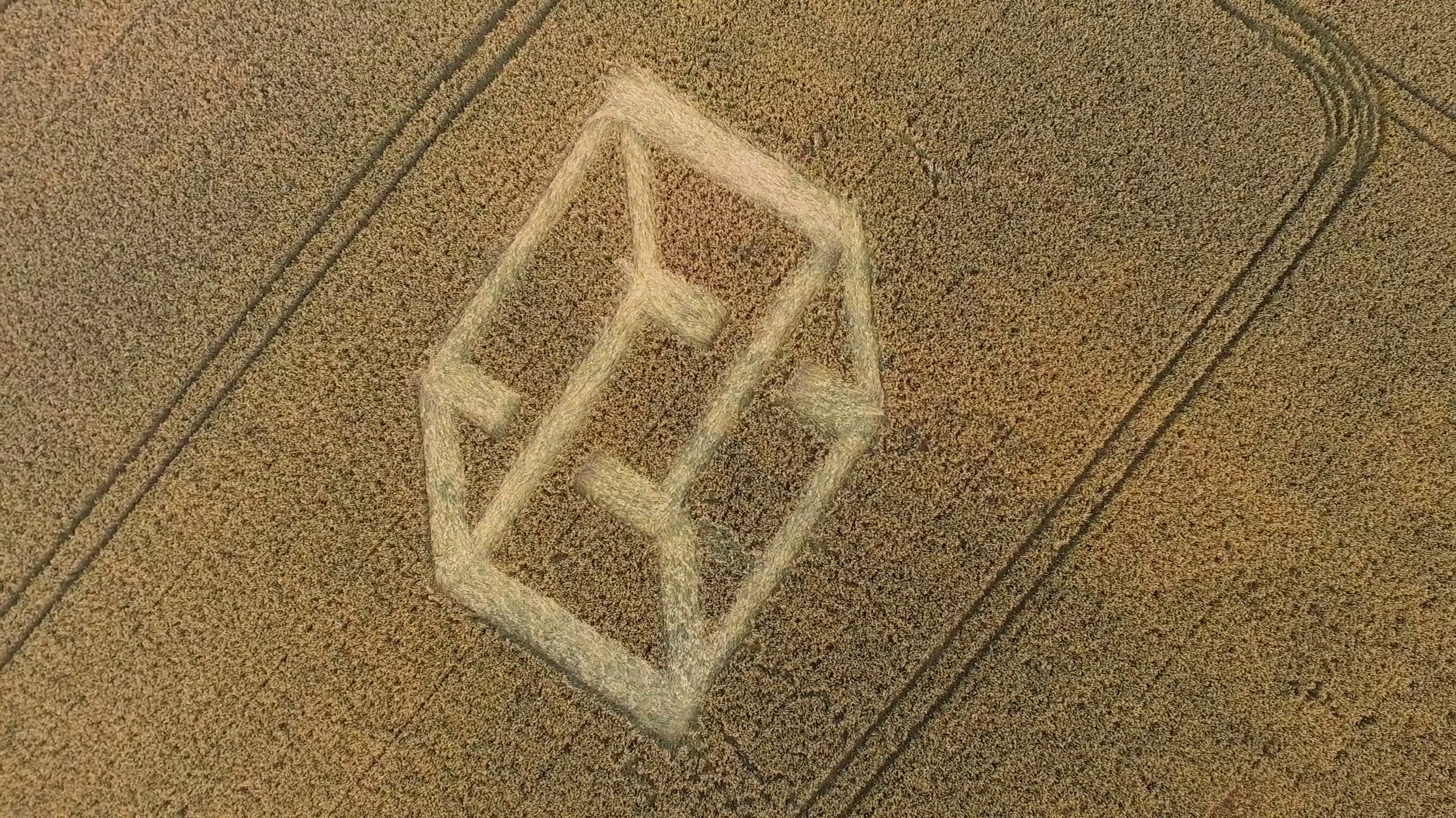
De Mannen van Holwerd aan Zee
(The Men of Holwerd by the Sea)
The liveability of the village of Holwerd threatened to deteriorate. To counteract this development, the village itself came up with an ambitious proposal that made everyone involved enthusiastic: Holwerd aan Zee (Holwerd by the Sea). Residents, water engineers, entrepreneurs, artists and nature lovers see advantages and opportunities, and are anxious to get started. Fifty years ago there were plans in this area to further impolder the Wadden Sea. Now, in the same area, there are opposite plans, in which the natural dynamics are given more space. The plan calls for a breach in the sea dike to reconnect the Wadden Sea with the hinterlands. A dynamic interplay between man and nature, water and land, old and new. Nowadays the Wadden Sea is UNESCO World Heritage which creates opportunities for people and nature.
Commissioned by Sense of Place, Linette Raven honours the four initiators of Holwerd aan Zee with this installation ‘de Mannen van Holwerd’. It forms a symbolic prelude to the water that is to come. When standing face to face with these men, you are reminded of the fact that with ambitious plans and unified strength, a lot is possible. The artwork is part of a walking route that connects the village with the salt marshes of Staatsbosbeheer.
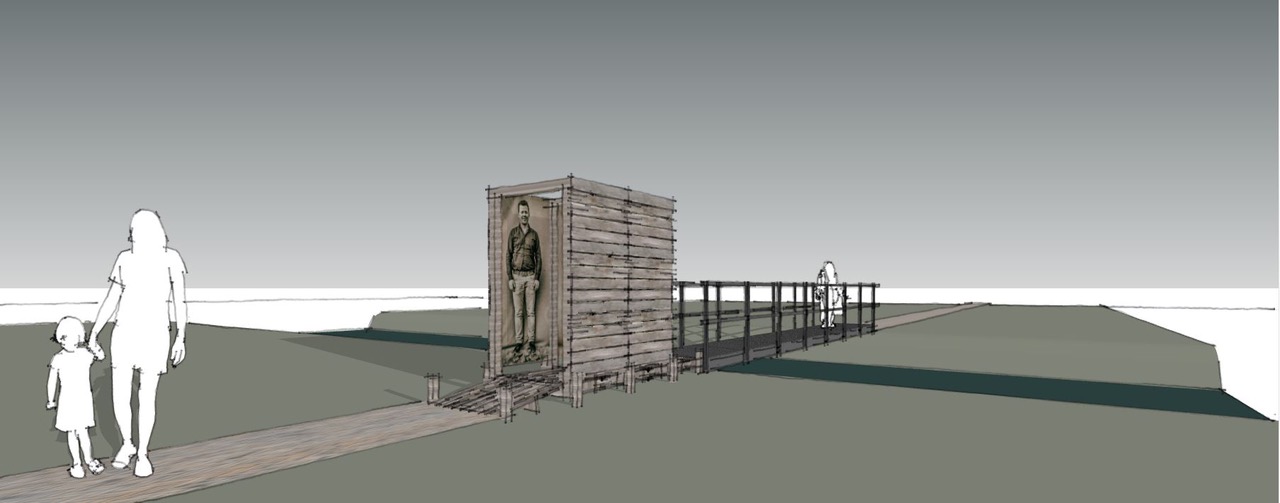
Natuurlijk is ook Sense of Place aanwezig bij het bruisende openingsweekend van Leeuwarden-Fryslân 2018! Op zaterdagavond 27 januari kan het publiek in ‘alle hoeken en gaten’ van de Leeuwarder Binnenstad kennis maken met het programma van dit bijzondere jaar.
De bijdrage van Sense of Place staat in het teken van klei. Twintig vrijwilligers uit het dorp Blije lopen tussen 19.00 en 21.00 uur met kruiwagens vol klei in een optocht door de stad. De klei staat symbool voor ons evenement “we wolle ús klaai werom” in augustus 2018 in Blije. Maar elke kruiwagen met klei vertelt ook iets over al die andere Sense of Place projecten die in 2018 de unieke geschiedenis en de prachtige natuur van het Waddengebied zichtbaar maken. Een landschap van water en klei. Vooraan deze stoet van ‘kleiwagens’ niemand minder dan de stille fanfare!
In vol ornaat, in mooie kostuums en voorzien van diverse ‘instrumenten’ marcheert de stille fanfare voorbij, zonder ook maar een noot te spelen. Het geheel voltrekt zich in totale stilte, op het ritmische geluid van de voetstappen van de fanfareleden na en de wielen van de kruiwagens. Aan het hoofd de Markies-Generaal die als maître-tambour het gezelschap met vaste tred leidt. Waarheen is het korps op weg?

Komend weekend start Leeuwarden-Fryslân 2018. Vrijdagavond 26 januari worden er in de hele provincie bij mensen thuis, op bijzondere locaties en in musea verhalen vertelt. Joop Mulder van Sense of Place, geboren Bolswarder, is ook van de partij. Joop vertelt zijn verhaal in de raadszaal van het prachtige Bolswarder Stadhuis, letterlijk op de stoel van zijn vader, ooit burgemeester van Bolsward. 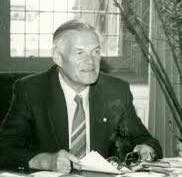
Als jongen op de katholieke HBS in Bolsward was Joop goed in wiskunde, maar ook creatief. Allerlei uitspattingen op dat gebied hadden zijn interesse en dus wilde Joop in de kunsten. Burgemeester Mulder was daar geen voorstander van: “Ga toch wiskunde studeren !” Maar Joop zette door, dan maar zonder studie. Na omzwervingen belandt hij op Terschelling. Hier krijgt Joop zijn scholing op “Kunstacademie Terschelling”. Hij bouwt er zijn eigen podium, eerst in zijn kroeg de Stoep, toen op straat en uiteindelijk met Oerol op het hele eiland. Maar Joop’s droom gaat verder: met landschapskunst de natuur en het verhaal van de Wadden nog intenser beleven: a Sense of Place.
Vrijdagavond vertelt Joop op de stoel van zijn vader zijn verhaal over VannU, ’ t Diekje en niet te vergeten Otteloeres. Verhaalt hij over zijn “Kunstacademie Terschelling en over Sense of Place.
Kroegpraat, oude koeien uit de sloot maar ook een verhaal over dromen en een visie op cultuur .
Als je toch niets te doen hebt !
Vrijdag 26 januari. Aanvang 19.30 en 21.00 uur. Stadhuis Bolsward. Duur 45 minuten.

De werkplaats van Jan Ketelaar is tijdens het openingsweekend van LF2018 op zaterdag 27 januari tussen 11.00 en 17.00 uur te bezoeken. In de werkplaats is de voortgang te zien van “Wachten op hoog water” twee metershoge, van metaal gelaste vrouwfiguren, die in juli 2018 als onderdeel van Sense of Place op de dijk bij Holwerd komen te staan.
Gastexposanten bij de open werkplaats zijn: Jenny Paula Piso en Wilma Borm. Muzikant Kaye is aanwezig met zijn harmonica. De stichting Craftwurk verzorgt een fijnproeverij. Daarnaast is er een koffietafel.
Wie zelf werk wil exposeren of muziek kan maken de nog komende open middagen, kan contact opnemen via wilma@janketelaar.nl.
De open werkplaats van Jan Ketelaar is aan de Tussendiepen 6 in Drachten.
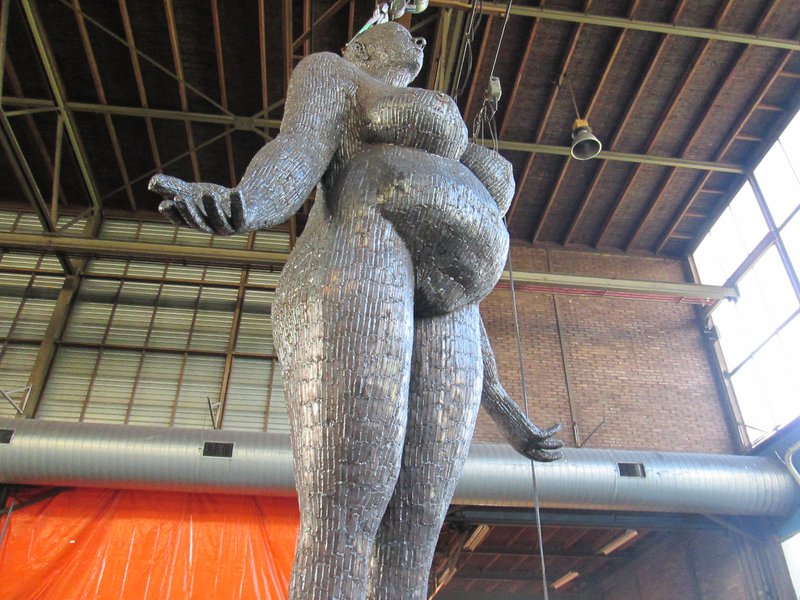
Per 1 januari 2018 is Henk van der Zwaag gestart als zakelijk directeur van Sense of Place. Hij volgt in deze functie Klaas Hernamdt op, die zich vanaf deze datum als strategisch adviseur richt op de langetermijnontwikkeling van Sense of Place.
Van der Zwaag was tot voor kort algemeen directeur van Empatec. Hij zal zich in zijn nieuwe functie samen met Joop Mulder in eerste instantie richten op de realisatie van het Sense of Place programma in 2018, het jaar van de Culturele Hoofdstad Leeuwarden – Fryslân 2018.

Kerend Tij (Turning Tide)
Sense of Place is presenting two new exhibitions, both of which will open at venues in Leeuwarden on April 4, 2018. At the city’s Aegon building and the De Kanselarij ‘open community’, you will get a chance to smell, taste and experience the former Dutch Middelzee, the estuary mouth of the River Boorn (now located in Friesland province) which used to run northward to the Wadden Sea.
Exposition Aegon building by Alex van de Beld.
Exposition De Kanselarij by Bruno Doedens.
Alex van de Beld studied at ‘de Academie voor Bouwkunst’ in Groningen. After 20 years as partner in Onix Architecture and over 100 architectural projects being build, it was time for him to move on.
Many things has changed in the field of architecture; unclear politics and unstable economic conditions make clients request new approaches in order to reconnect the profession to society.
A couple of years ago, Alex began working from a different perspective in the periphery of architecture and founded
ALBSurroundings. He will continue his international search on behalf of Onix Sweden…
Working in the peripheral surroundings, Alex tries to discover new connections between landscape and design, art and theory, politics and urbanism, culture and education. Above all, his mission is to mediate the way people live in man-made environments.
Bruno Doedens (1959) studied at ‘de Academie van Bouwkunst’ in Amsterdam, specialising in Landscape architecture. In 1990 he wins the ‘basisprijs Prix de Rome’ – Landscape architecture. Together with Maike van Stiphout he starts bureau DS in 1993. They win the international contest for designing two parcs at the Potzdamer Platz in Berlin. Both have been realised. In 2005 Doedens continues on his own, from 2007 as initiator and artistic director of Slem. Besides expertise and crafts, the focus in all his projects lies on illusions. The fascination to ‘make the impossible possible’, or ‘to turn water into wine’, and the focus on the long term and the social and cultural values, predominate.
For more information: Bruno Doedens
Exhibition dates: from 04.04.2018 to 25.11.2018
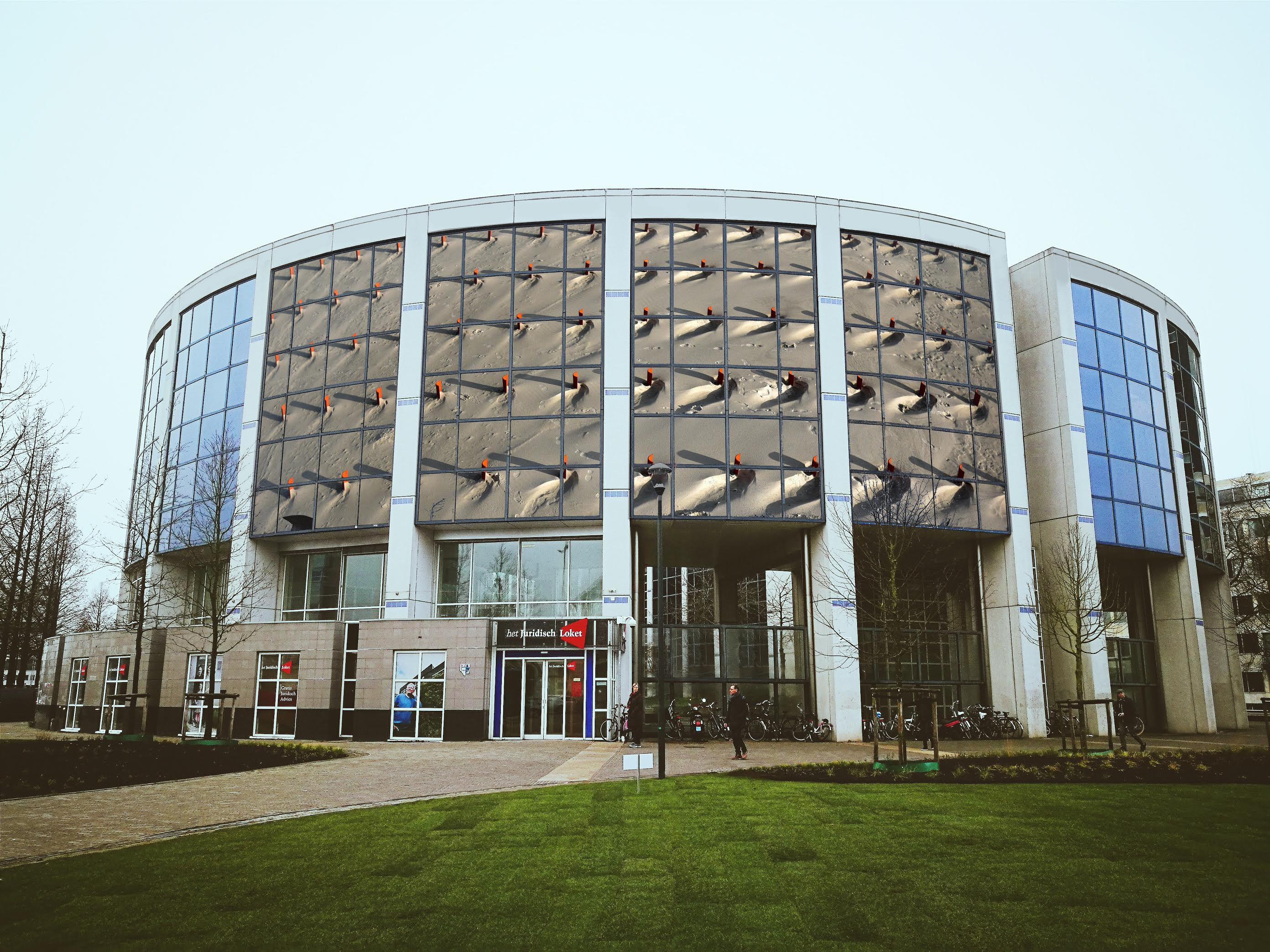
Another startling work which challenges people’s perceptions of the land and its uses is artist Nienke Brokke’s ‘Dijk van een Wijf’, a huge sculpture of a reclining female nude, formed from the earth and green grasses of the dike near the Frisian village of Holwerd. This organic monument – around 20 metres high at the hips and shoulders – forms a barrier between the land and the sea, sheltering the nursing grounds of seed, soil and people from the sea.
The dyke is a body which we trust and support, behind which we can hide from the dangers of the sea. The dyke as patron of North Friesland, sheltering the nursing grounds of the seed potato and soil for numerous other vegetables. Together with the sea barrier, she provides security, safety, as unconditional as a “Dijk van een Wijf” should!
This ‘land art’ project created by Nienke Brokke on the dike at Holwerd will serve as a warm welcome for all travellers from Ameland.
The visual work of Nienke Brokke always has a context with a narrative element. Her theatre design studies at the Rietveld Academy have contributed to this. As theatre is always a ‘gesamtkunstwerk’, Nienke likes to involve multiple art disciplines which together form a whole. Thanks to this narrative side, Nienke Brokke also designs education projects, in addition to IM and theatre décors. She is skilled in connecting the content with an art discipline.
The land art proposal ‘Dijk van een Wijf’ was her graduation project at the Rietveld Academy in 1997, and we are working hard on making it reality in 2018.
For more information: NienkeBrokke
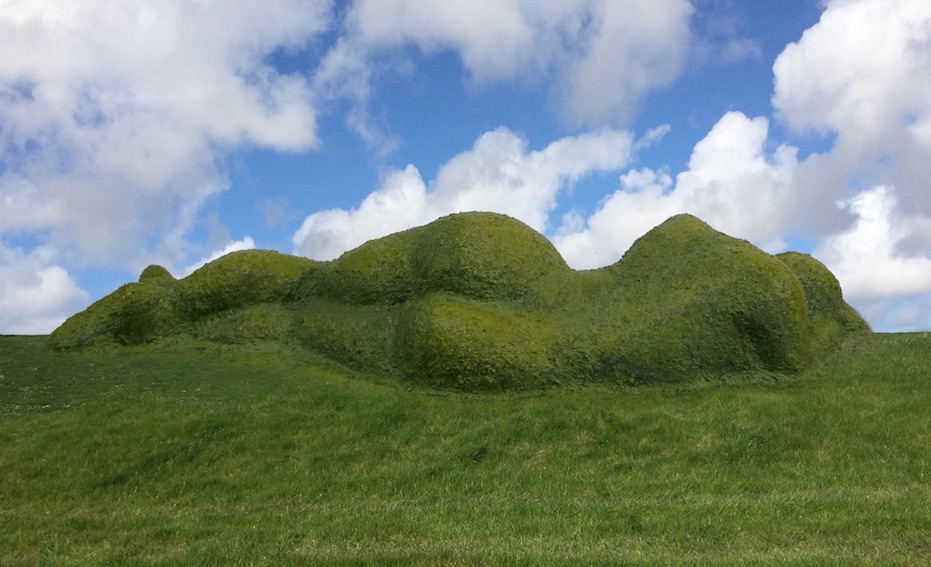
This exhibition of the ‘Blije Church’ photography project by Maarten Boersema, a pastor in the Frisian town of Blije-Holwerd, tells the story of the life of a village preacher and community life in an area beset by a declining population. These intriguing, inspiring, often stunning and affecting pictures show the life of one person in a village community, along with the important role faith plays in this deeply religious North Frisian town.
Boersema will be exhibiting a selection of the photographs in conjunction with Sense of Place in 2018. The mood of the ‘Blije Church’ is replicated inside the barn of an authentic old farm. The artist has selected some of the most arresting images, depicting beauty and horror, good and evil, and joy and despair.
After earning his Master’s degree in Theology from the Theological University of the Reformed Churches in Dampen, Overijssel province, artist Maarten Boersema (b. 1986) joined the Liberated Reformed Church in Blije-Holwerd as a part-time preacher in September 2014. He began his blijekerk.nl project that same month. In recent years he has also honed his talents as a photographer and author, having published both his written work and his photographs in publications such as ManagementTeam, Discovery Magazine, Medisch Contact, Nederlands Dagblad, Huffington Post and The Scientist.
http://www.blijekerk.nl/
Expected exhibition dates: 01.05.2018 to 01.12.2018

This project by artist Esther Kokmeijer features a sea of cornflowers stretching from the village of Holwerd all the way to the Wad (mudflat). The initiators of the Holwerd aan zee project seek to restore the link between the Wadden Sea and the village of Holwerd through a breach in the dike. In summer 2018, a carpet of blossoming, sky-blue cornflowers will cover part of the course of this future new waterway, thereby symbolising the ideal of ‘Holwerd aan Zee’ (‘Holwerd by the Sea’).
Esther Kokmeijer (born in Brantgum in Friesland in 1977) earned her degree from Hogeschool der Kunsten in Kampen, Overijssel province. Having travelled across the world, she explores in her travels the world’s complexity and seeks to recreate this in her art, taking a keen interest in the interaction between people and the landscape.
Expected exhibition dates: summer 2018

This new walking route will take you along a site known for a memorable episode in Friesland province’s recent history.
When a huge storm surge pushed seawater into the earth outside the dikes of the village of Marrum on the night of October 31, 2006, 150 horses ended up stranded on a knoll (a type of small island) behind the dike. After a joint effort involving wranglers, firefighters, veterinarians, animal welfare officers and the Dutch Army had failed to bring the animals to safety, six local women on horseback successfully herded all but one of the horses across the path. It was an extraordinary event, and the story of the Marrum Horse Rescue is etched in the collective memory of Dutch nature lovers and horse aficionados alike. A memorial was subsequently erected in 2011 to mark the bravery and ingenuity of these women.
At the initiative of Plaatselijke Dorpsbelang, a local interest group, a new walking route was designed that leads to the site of the rescue and which connects to the walking paths behind the dikes. The Noordoost aan het Wad project, which was launched in 2016 by the Agenda Netwerk Noordoost (ANNO) network of the communities of Dantumadiel, Dongeradeel, Ferwerderadiel and Kollumerland, is a development partner in this project.
‘Noord-Fryslân Bûtendyks’ consists of summer polders, ‘dobben’, salted grasslands, mud fields and salt marshes. The area is over 4180 hectare. You will find many birds here, including meadow birds like the redshank and yellow wagtail. They are joined in winter by the brent goose and barnacle goose, finding their food for the winter.
Salt-loving plants are responsible for the beautiful colours in this area. Planten die er onder andere voorkomen zijn zeekraal, zeeaster, schorrekruid, spiesmelde, gewone zoutmelde, zeeweegbree, melkkruid, aardbeiklaver en zee alsem. Op de hoger gelegen delen komen er vooral zwenkgras, herfstleeuwentand en zilverschoon voor.
‘Dobbepaarden’ is a project in collaboration with It Fryske Gea.
Realisation: July 2018
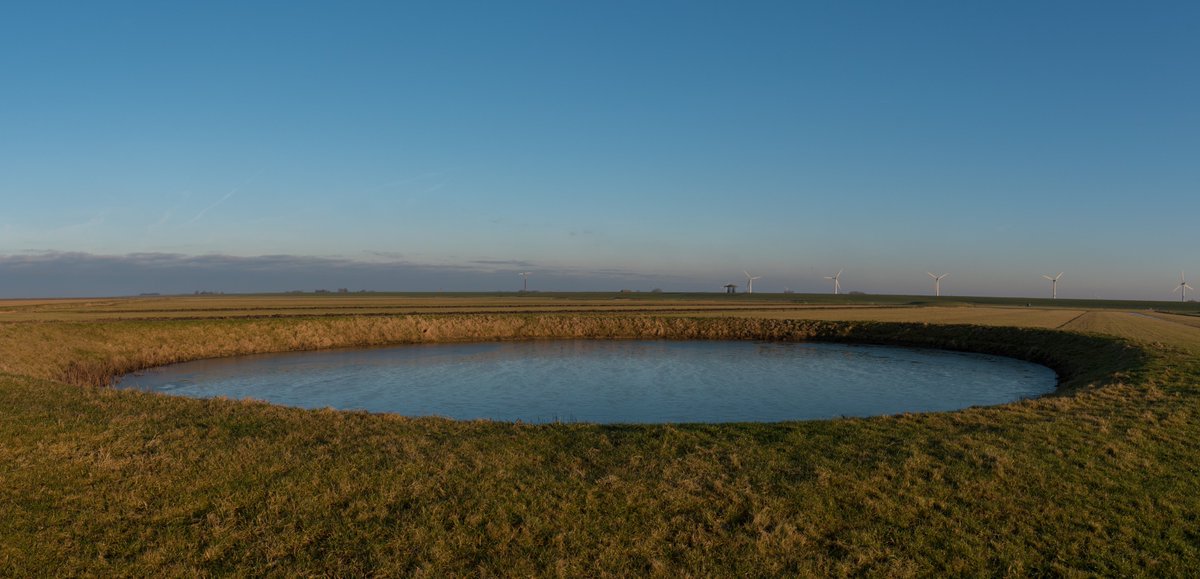
The Kromme Horne has it all: an abundance of light, vastness, serenity and spectacular panoramas. If you enter this curved pier at the village of Wierum, you will find yourself surrounded by hollows, salt marshes and plates, accompanied by the infinite light. At the end, like a ship on the horizon, you will spot a sculpture. Go on board and wander through the halls, whose windows will lead you to destinations unknown…
A curved 550-metre pier will run along the dike near the village of Wierum in the future. Visitors can walk across the pier, which runs mostly along the old pier and protects it from further decline. As they walk above the water and the slurry and along three panoramic views and dwellings, they experience the beauty of this unique landscape. The tidal pool appears like a mirage, a ship with the bow turned toward the north: this is where the light is caught in a room – a room which provides protection from the wind and the sun and which entices you to linger, walk out onto the mud flats or swim or paddle in the water.
The Kromme Horne landscape object was created by and for people and in harmony with the natural world. The three ‘roundabouts with exits’ represent the spaces where the tide is caught. The leads to the creation of blowholes which – due to the currents – have had their appearance transformed over the decades. The landscape will be home to salt marshes and rift valleys, with mussel beds to be installed at one and vegetation planted at another, while the presence of the pier will also cause the existing salt marshes to grow again.
In an effort to revitalise their village, several of Wierum’s residents decided in 2016 to explore opportunities for new recreational facilities. Many different ideas were proposed and brainstorming sessions were held, including an exchange of ideas and various drawings. It was clear that a spatial element needed to be added to highlight Wierum’s visual qualities: the salt marshes, the mudflats, the endless dikes, the tranquillity, the tide, the colours, the light, the unique history, and the link to local shipping and hiking routes. The visual artist Ruud Reutelingsperger, a member of the Observatorium artist collective, became involved in the initiative, which ultimately resulted in this project.
The upshot was that the residents of Wierum saw a longstanding wish become a reality.
More information: dorpwierum and observatorium for the great design!
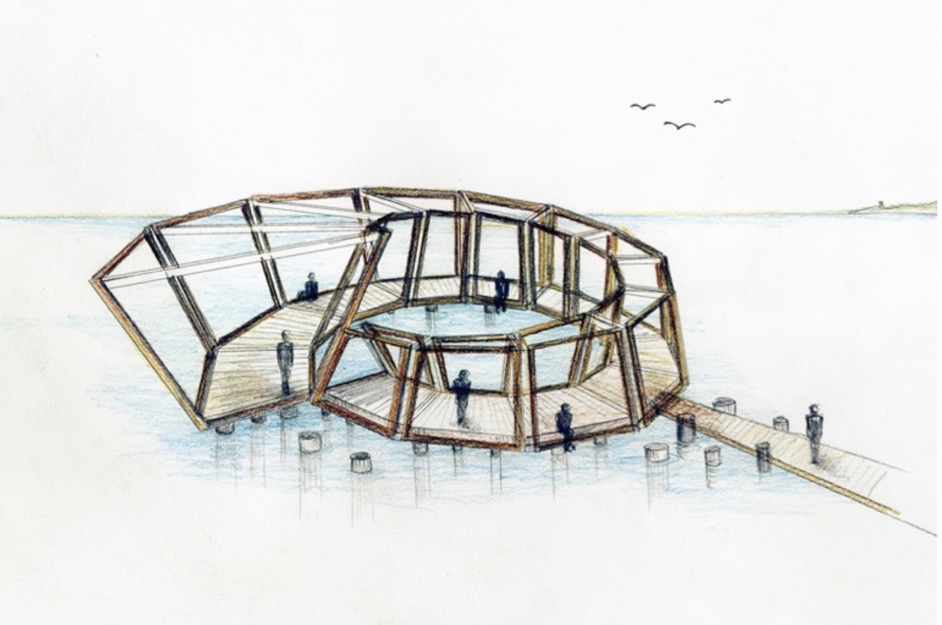
A village with a unique history, bordering the 130 km long Wadden dyke. It is a village surrounded by beautiful scenery with many qualities.
To boost the liveliness of the village, a number of residents started to research the possibilities for the development of new recreational facilities.
Three subgoals, which can contribute to the vitality of Wierum were mentioned by the initiators:
extend the stay of visitors
strengthen the connection between the different regional networks
experience the many qualities of the village and environment better
On the 24th of November 2016 the initiators organised a “Schetsschuit” to explore how these goals can take shape. This resulted in an energetic brainstorm with over 20 participants, stakeholders and residents from the region. All ideas were examined to be able to explore the possibilities and restrictions.
The ‘Wierumer Aak’, the ‘Frisian tide clock’ and the sea wall near Wierum are the inspiration for the tide pool in Wierum.
The coiled Nautilus shape, an almost Escher -like drawing of how the turned V- shape of a dike transforms in the V-shape of the barge. The fence creates windows (and window sills) to view the surrounding landscape. The infinity of the Dutch Shallows on the one side and the powerful line of the Frisian See dike with the church tower of Wierum on the other side.
A pavilion, build outside the dike, and connected to the existing dike body. A shell, meaning it can be used for many different activities and adjusted/ completed with temporary installations, for example to provide protection against wind and sun.
At high tide the water will rise to just below the floor. The pavilion can also still be reached at low tide. The difference in altitude in the pavilion also reflects the difference in altitude between low tide and high tide. (approx. 2 to 2,5 metres).
The tide pool is part of a total plan, which is being developed. A pier, beach and salt marsh are also included in the final design. For more information: dorpwierum and maatschap Observatorium responsible for the great design!

Het Bildt wheat fields art project.
Picture this: summer 2018, wheat fields rippling in the wind in het Bildt; the clay land along the Frisian Waddendijk dike. The sight of drawings by several Bildt-based artists carved into the local wheat fields is nothing short of spectacular on this agricultural land, traversed by the straight lines of dikes, waterways and ditches. A long-time resident of het Bildt, artist Henk Rusman, who conceived the project, creates massive statues of steel and stone patterned on the local scenery. When the artist gazed out across the wheat fields one summer, he had the ingenious idea of creating ‘art in the wheat’. We previously got a taste of this style in 2017, when he and fellow artist Marco Goldenbeld created a work of art inspired by Escher’s ‘impossible cube’. For the 2018 project, Rusman invited several artists from het Bildt to supply designs for his ‘Art in the Wheat Fields’ project. The works will be displayed during the Bildtse Aardappel weken (Bildtse Potato Weeks) in 2018. If you don’t suffer from vertigo, you can view it all from the Ferris wheel brought in especially for the occasion!
Born in Hillegom in South Holland province, Henk Rusman attended the Stadsacademie and Jan van Eijck academie, two art colleges located in Maastricht in Limburg province. A long-time resident of het Bildt and renowned in the Netherlands and beyond for his larger-than-life works, he received the Bildtse Kultuurprijs, an award acknowledging contributions to local culture, in 1993.
Expected exhibition dates: summer 2018
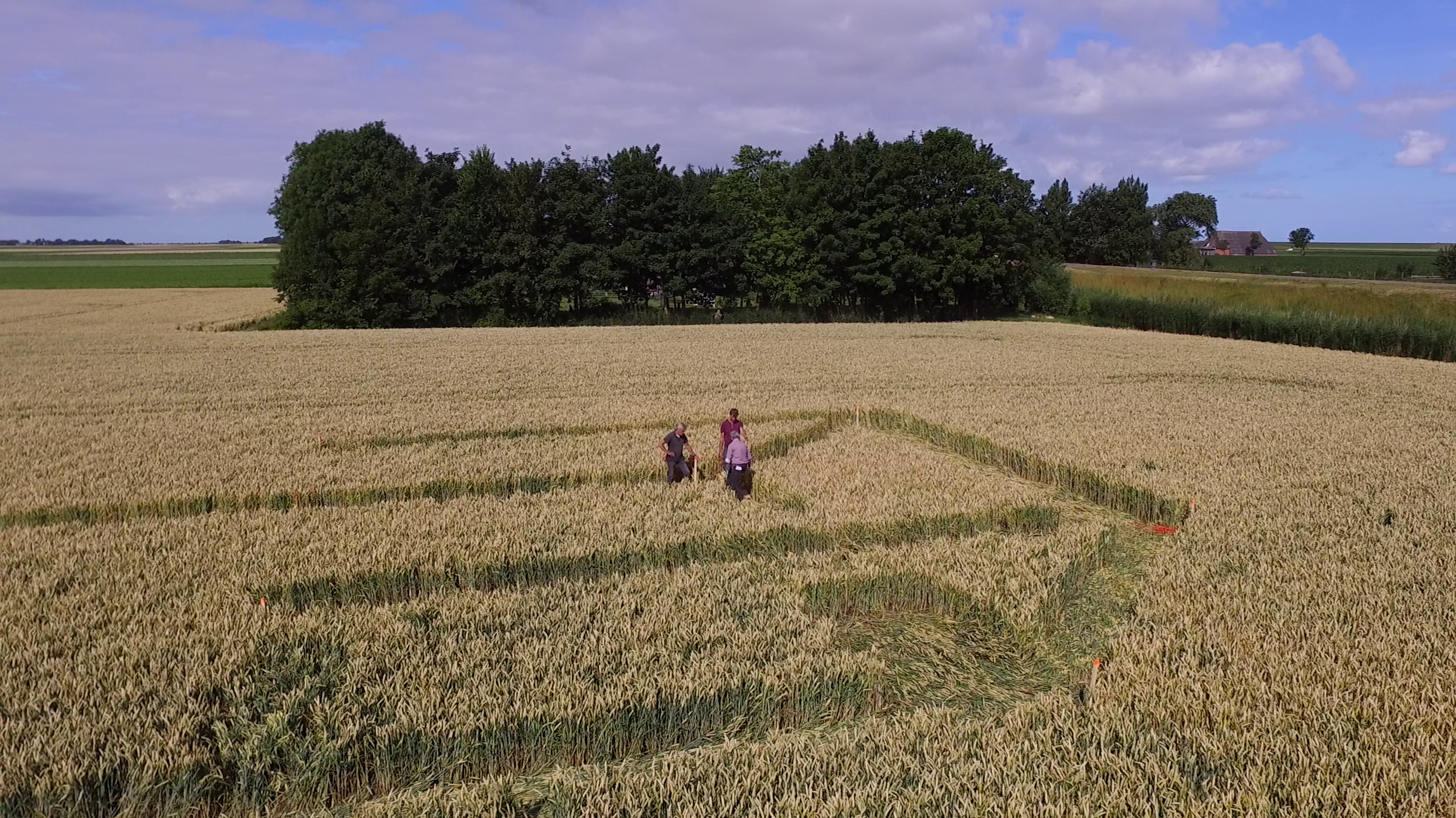
The ‘Men of Holwerd’ installation, created by artist Linette Raven, is a tribute by Sense of Place to the four initiators of the ‘Holwerd aan Zee’ (‘Holwerd by the Sea’) project. The installation depicts a sea lock with flowing water, featuring four life-size portraits of men at the interior of the lock. Visitors walk through a corridor of potato crates and stand eye to eye with these extraordinary men.
Through the ‘Holwerd aan Zee’ project, the initiators seek to break the negative spiral of population loss and economic decline in the village, proposing that there must be a breach in the dike in order to restore the link between the Wadden Sea and the hinterland. Residents, hydraulic engineers, businesses, artists and nature lovers are all keen to devote their talents and energy to the project, which represents a dynamic interaction between man and nature, water and land, and old and new. It presents both an economic opportunity for the village and the area as a whole, and an ecological opportunity for the Wadden.
A portrait photographer who likes to tell the story of ordinary, everyday people through her pictures, Ms Raven both initiates her own art projects and collaborates with others. One of her best-known works is Fan twa kanten (‘From Two Sides’), which features 182 portraits of residents of Terschelling island, presented in a life-size format in an outdoor location. She is also renowned for Pioniers van de Wieringermeer (‘Pioneers of the Wieringermeer’), featuring portraits of the first 40 residents of this polder. For further reference, see the Sense of Place project ‘Bildtstars en Eigenheimers’ (‘Bildtstars and Eigenheimers’)
Expected exhibition dates: from May 2018 until 2019

We write the year 2018
On the dyke near Holwerd a breathtaking statue looks out over sea:
‘Waiting for high water’.
The statue consists of two metal welded 5 meter high women. One big woman, the other one slender. You can position yourself in-between these women, and take their hand. What the artist is trying to accomplish, is for the statue to reunite people. The statue represents the search for balance and exchange.
This art piece is still in the making and Sense of Place wants to assist the artist, Jan Ketelaar to be able to finish it.
The women are, after all, part of the trail ‘Expedition Sense of Place’.
Jan was able to finance the big woman himself, but the big woman needs the other lady! And to be able to finish her, help is needed.
Through a crowdfunding, Sense of Place, wants to raise an amount of € 10.000,- for Jan to be able to bring the slender lady to life. For as little as € 10 one can contribute to the realisation of this remarkable project on the Wadden Coast.
kick-off crowdfunding at festival ‘Explore the North’ on the 25th of November in Leeuwarden.
It runs until January 8 2017 at ‘voor de kunst‘.
Help us help Jan and go to this site!
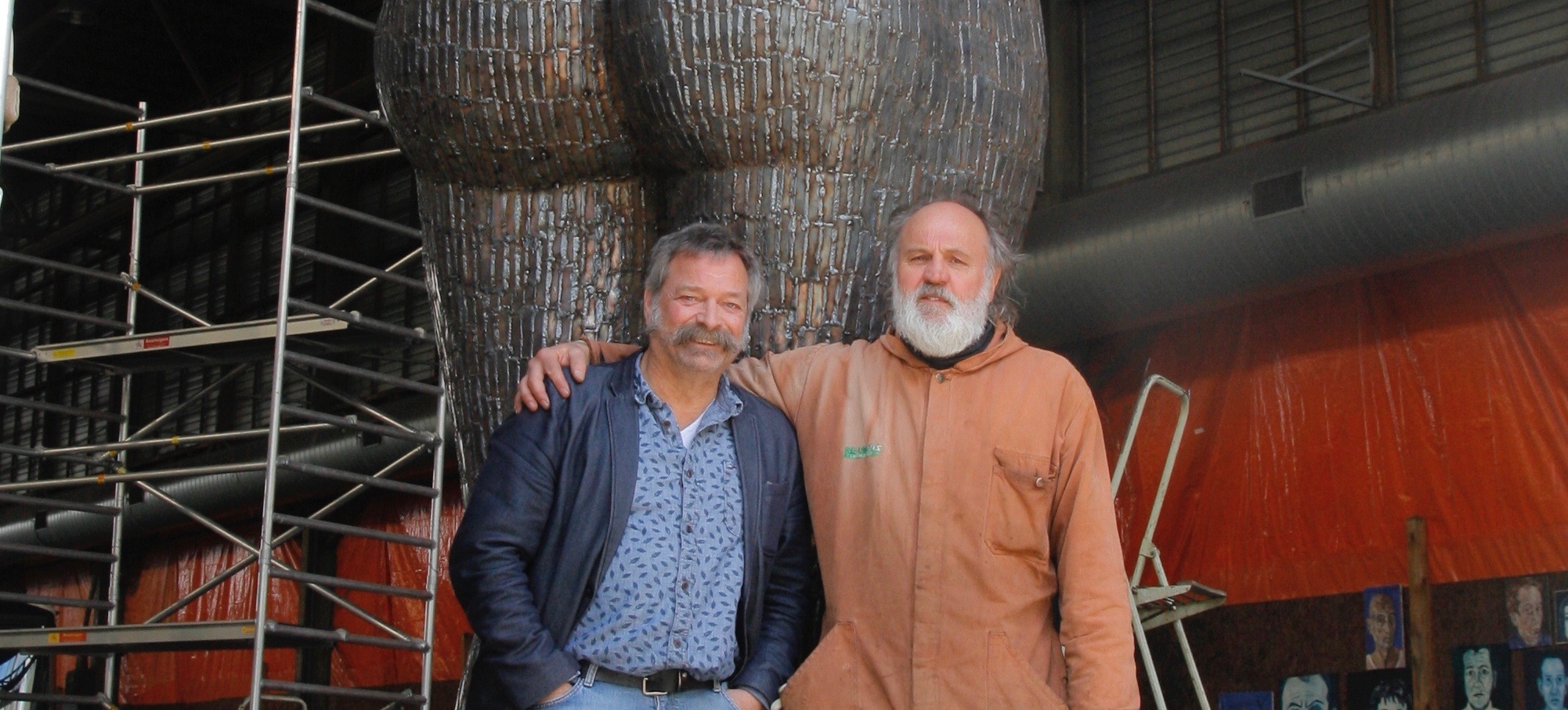
“Mound of the future”
Mounds (terpen) are an important feature of the Frisian landscape. Their long and rich history in the area appeals to the imagination, while they also raise questions when it comes to archeological details and serve as an inspiration for art, culture, and future developments in the area.
Various people have dreamed of creating the Terp fan de Takomst (‘Mound of the Future’) for some time: a new mound outside the dikes, for research and educational purposes, as a model for the original design, to experiment with new and old brackish crops, and as a place for reflection and contemplation.
The village of Blije has taken the initiative to actually build its own Terp fan de Takomst (‘Mound of the Future’). The village, which feels closely connected with the mudflats, states in a report in which it outlines its vision, “We want to face the Wadden Sea again as we live our everyday lives.” A central element of their plan is to build a new mound outside the dike, at the level of Blije village. Their objective is to create a new place of inspiration, to attract people to the village and the Wadden coast, to share ancient tales with one another, and to create new narratives.
A partnership of Dorpsbelang Blije, It Fryske Gea, the Terpencentrum (a scientific research body part of the Groningen Institute of Archaeology, which is affiliated to Groningen University), and Sense of Place, has established a project group with the objective of turning this dream into a reality.
The first concrete steps will be taken in 2018, the foundation for the path will be laid, and the fundamentals will be put in place for the We wolle ús klaai werom (‘We Want Our Clay Back’) project.
Created by the Observatorium artists collective, the design for the Terp fan de Takomst project is conceived as an ‘artwork’ which appeals to the imagination of every stage of the development process, and serves as a destination for residents and visitors at each of these stages: a ‘Growing Mound’.
Mounds range in size from narrow (5 metres) and low (1 metre) to wide and high (up to 10 metres). Depending on their size, mounds can support anything from one house to a small hamlet to a church, and through the Groeiende Terp (‘Growing Mound’) the Observatorium artist collective wants to visualise and make people experience this process of stacking different layers on top of each other.
Designers are carefully outlining the future shape of the Mound using piles and a spiral pattern, starting at the bottom and ending at the top. The various stages are arranged horizontally, rather than vertically, thereby ensuring that each stage in the growth is and remains visible. One of the mounds will support a house and includes a core platform; a knoll will be added complete with a wall, and the drawing of the piles will ultimately result in a fully developed mound. The beginning is marked by a platform and the end by a wall (as a cross-section) of wood piles at the eventual height.
The clay will be supplied over the years, until the vision has been fully realised and the mound is exactly as it should be.
Expected exhibition date: this project is under development

Few people are aware that a large number of the nearly 1,000 mounds (terpen) found in Friesland province at one time have been excavated, with the clay being used to enrich the peat soil and sandy soil in more economically disadvantaged areas. Although canals were dug, railway lines installed, and so on, the episode – which involved a massive operation – is barely a footnote in local history books. In order to revive this part of the province’s history, researchers are attempting to establish what happened to the clay, and the local population has been symbolically reclaiming the clay by sourcing it from different areas.
The village of Blije is currently building the Terp fan de Takomst (‘Mound of the Future’). In the autumn of 2018, toward the end of year in which Leeuwarden and Friesland are the Cultural Capital of Europe, the village will request all villages and farmers from the North of the Netherlands to return a small shovel or wheelbarrow filled with the ‘relocated’ clay to the village of Blije. This will then be used to plant the Terp fan de Takomst, a safe new meeting place outside the dike. The return of the clay will be commemorated in a special way.
We wolle ús klaai werom is a one-day event designed to raise awareness of the rich history of the Frisian landscape
Exhibition date: 18.09.2018

The six sheltered workshops in the Wadden region joined together and will support Sense of Place with the realisation of a number of projects.
Duurzaamheid als thema voor onze wereld betekent ook dat je mensen met een beperking inzet in het arbeidsproces en daarmee in onze maatschappij. Niet voor niks heeft Sense of Place als doel om samen te werken met maatschappelijke organisaties en overheden waar juist ook deze kant van duurzaamheid centraal staat.
Op initiatief van Mulder gaan de SW-bedrijven rondom het Wad samenwerken met Sense of Place. Onder coördinatie van Empatec te Sneek zijn dit: Ability, De Bolder, Empatec, Fivelingo, NEF en Noorderkwartier.
De kracht van de bedrijven van ‘Wad bindt ons!’ ligt in het opleiden en ontwikkelen van mensen met een arbeidsbeperking, en ze binnen hun mogelijkheden in het arbeidsproces in te zetten. Dat is de kerncompetentie van nu en tot ver in de toekomst van de in ‘Wad bindt ons!’ samenwerkende bedrijven. Vanuit dat concept past natuurlijk het vele werk wat Sense of Place met zich meebrengt uitstekend. Daarbij kunnen we denken aan inrichting en onderhoud van cultuurpaden, kunst- en culturele objecten. Een mooi voorbeeld hiervan is dat Sense of Place een cultuurroute langs de kust creëert en ‘Wad bindt ons!’ die logistiek vorm gaat geven met rustplekken, ingevuld met banken en tafels, uitkijkpunten, bewegwijzering, wandelroutes, etc. In samenwerking met kunstenaars en architecten gaan de gezamenlijke SW-bedrijven hier inhoud en vorm aan geven. Inzet van de werkplaatsen en de arbeidskrachten zorgen voor een mooie werkgelegenheid en aansluiting bij het maatschappelijk belang dat de cultuurroute poogt te bewerkstelligen, die van het stimuleren van cultuurtoerisme. Maar ook ontvangst, toelichting, beheer, aanspreekpunt, gastheerschap zijn functies die uitstekend verzorgd kunnen worden door ‘Wad bindt ons!’. Opgeteld gaat het om meer dan 5.000 werknemers die bij de 6 SW-bedrijven in het gebied rondom de Waddenzee werkzaam zijn.
Op korte termijn wordt gewerkt aan het masterplan dat de basis moet zijn voor de samenwerking tussen Sense of Place en ‘Wad bindt ons!’, met daarbij de blik op 2018 en verder.
The photo installation ‘Bildtstars en Eigenheimers’ gives an identity to the potato farmers from the provinces of Friesland and Groningen. Potato farming is one of the most distinguishing features of the Wadden Area scenery, while the potato farmers themselves are significant to the Frisian and Groningen identity and culture. Their land also gives them a special role in the scenery of both provinces, and the portraits painted by Linette Raven lift them out of their anonymity. Their portraits are exhibited under various bridges in Friesland province (until the end of 2018) and in potato fields along the Wadden coast (2019 and beyond).
A portrait photographer who likes to tell the story of ordinary, everyday people through her pictures, Ms Raven both initiates her own art projects and collaborates with others. One of her best-known works is Fan twa kanten (‘From Two Sides’), which features 182 portraits of residents of Terschelling island, presented in a life-size format at an outdoor location. She is also renowned for her ‘Pioniers van de Wieringermeer’ (‘Pioneers of the Wieringermeer’) series, featuring portraits of the first 40 residents of this polder.
Sense of Place is one of the supporting principles in the Leeuwarden Capital of Culture 2018 programme. Joop Mulder, founder and creative director of Oerol, contributed to Leeuwarden’s winning bid book, which included Sense of Place from the start.
In cooperation with Lwd2018, work will be carried out in the coming years on the realisation of a number of cultural-landscape projects. After a test phase during one or more editions of the Oerol festival, these will acquire permanent places in the Frisian Wadden region.
Lwd2018 presented the first of these projects during Oerol 2014 and 2015, in the form of an exhibition at the Sense of Place Showroom. During both festival editions, visitors could talk to Lwd2018 about the underlying objective of bringing the Frisian Wadden area to life.
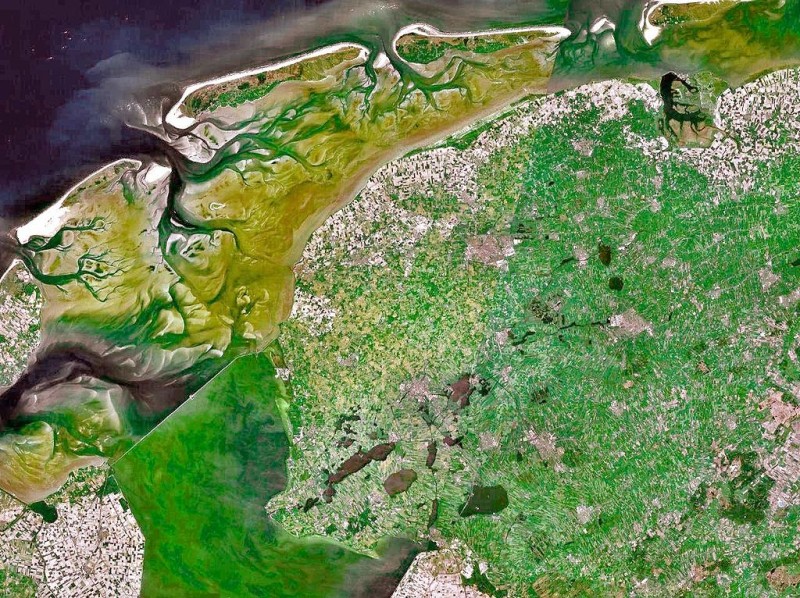
The De Nollen landward dune area in Den Helder is home to the ‘landscape of the imagination’. De Nollen is an existing art project featured in the Sense of Place programme. What once began as an artistic experiment in this old, neglected area has evolved into the life’s work of the artist R.W. van de Wint (1942-2006). He spent 25 years working on paintings, steel sculptures and large structures which are closely entwined with the dune landscape. The location and the image imbue the picture as a whole with meaning. Combining simplicity with complexity, his work is possessed of a real vitality that captures the viewer both visually and physically. In a world that’s changing at an increasingly faster pace, the artist sought to evoke a world of elementary images which have been the same for centuries: the light, the transition from light to dark, and the experience of colour.
This garden created by Van de Wint is reminiscent in style to the Henry Moore Studios and Gardens in Hertfordshire, England; Ian Hamilton Finlay’s Little Sparta garden at Dunsyre in the Pentland Hills near Edinburgh, Scotland; and the art collection at Museum Insel Hombroich near Neuss, Germany.
Reindert Wepko (Ruud) van de Wint (1942-2006) withdrew into the old landward dune area De Nollen after 1980, having stopped exhibiting in European museums at that point. De Nollen was to become his life’s work. Van de Wint is renowned for the paintings which grace the halls of the Dutch House of Representatives and ceiling frescos in the Groningen City Hall, as well as the working quarters of former Queen Beatrix of the Netherlands at Noordeinde Palace. In addition, he created around 35 sculptures, which are spread throughout the Netherlands. In 2002, an exhibition of his work was staged at the Kröller-Müller Museum in Otterlo: R.W. van de Wint. Clair-obscur. Seven Statues.
For more information: projectdenollen
